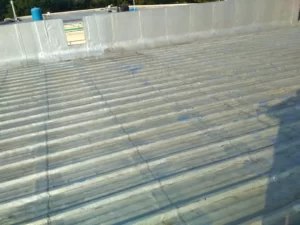1.Slope Roof Waterproofing – importance
Slope roof waterproofing is the process of protecting a sloped or pitched roof from water damage and leaks. Slope roofs are designed to shed water, but they can also cause water to pool in certain areas, which can lead to potential damage. Slope roof waterproofing is essential to prevent water from seeping through the roof and into the building’s interior, which can cause significant damage to the structure, insulation, and finishes.

In Case of RCC (Reinforced cement Concrete) Slope roof, Cracks and low compaction is the major disadvantages. Cracks in the concrete surface can allow water to seep through the roof and cause leaks. Cracks can occur due to improper installation, seismic activity, or exposure to extreme weather conditions also.
Regular maintenance of RCC slope roofs is essential to prevent leakage issues. Neglecting to clean gutters, repair damaged roofing materials, or address other issues can cause water to penetrate the roof and cause leaks.
Metal slope roofs are popular due to their durability, low maintenance requirements, and ability to shed water easily. However, like any roofing system, metal slope roofs can experience leakage issues if they are not installed or maintained properly. Here are some common causes of leakage in metal slope roofs:

- Improper installation: Metal slope roofs must be installed correctly to prevent leaks. This includes ensuring that panels are secured properly, seams are sealed correctly, and flashing is installed properly around any roof penetrations. Improper installation can cause water to penetrate the roof and cause leaks.
- Corrosion: Metal roofs can be vulnerable to corrosion, which can cause the metal to weaken and develop leaks. Corrosion can occur due to exposure to moisture, chemicals, or other environmental factors. Rust spots or other signs of corrosion should be addressed promptly to prevent leaks.
- Damage from debris: Falling branches, or other debris can damage metal roofs and cause leaks. It is important to regularly inspect the roof for signs of damage and repair any issues promptly.
- Expansion and contraction: Metal roofs can expand and contract due to temperature changes. Over time, this can cause seams and fasteners to loosen, which can allow water to penetrate the roof and cause leaks.
- Damage from Foot Traffic etc.: Heavy foot traffic or dropped tools can cause dents and punctures in the metal roof panels, which can compromise the integrity of the roof and lead to leaks. Foot traffic can cause fasteners to become loose, which can allow panels to shift or lift, creating gaps that can allow water to enter. To prevent damage from foot traffic on metal roofs, it is important to limit access to the roof as much as possible and provide protective measures, such as walkways or barriers, to minimize the risk of damage. If foot traffic is necessary, it should be limited to designated areas and conducted with care. It is also important to inspect the roof regularly for signs of damage and repair any issues promptly to prevent leaks from developing.
2. available systems for Slope Roof Waterproofing.
There are several systems available for slope roof waterproofing. Here are some of the most common ones:
- Modified Bitumen Roofing: This Slope roof waterproofing system is similar to BUR but uses a modified asphalt membrane that is reinforced with polyester or fiberglass. The membrane is typically installed in two or three layers and can be applied with heat or cold adhesive.
- Single-Ply Membrane Roofing: This is a newer type of Slope roof waterproofing system that uses a single layer of synthetic material, such as EPDM, PVC, or TPO. The membrane is typically applied in a single layer and is either adhered with adhesive or mechanically fastened to the roof deck.
- Liquid Applied Roofing: This Slope roof waterproofing system involves applying a liquid coating to the roof surface, which then cures to form a waterproof membrane. The liquid can be applied with a spray or roller and can be made of various materials, including acrylics, polyurethanes, or silicone.


3. selection of Slope Roof Waterproofing system
The selection of a slope roof waterproofing system will depend on several factors, including the roof design, climate, budget, and desired lifespan. Here are some key considerations to keep in mind when selecting a slope roof waterproofing system:
- Roof design: The type of roof design will affect the selection of a waterproofing system. For example, a flat roof with a parapet wall will require a different system than a pitched roof with a ridge.
- Climate: The climate and weather conditions in the area will affect the selection of a slope roof waterproofing system. For example, a roof in a region with heavy rainfall will require a system with good drainage and the ability to withstand climate cycles.
- Budget: The available budget will also be a key factor in selecting a waterproofing system. Some Slope roof waterproofing systems, such as BUR or modified bitumen, may be more affordable than newer systems, such as single-ply membrane or liquid applied roofing.
- Lifespan: The desired lifespan of the waterproofing system will also affect the selection. Some Slope roof waterproofing systems, such as metal roofing or liquid applied roofing, may have longer lifespans than others.
- Maintenance requirements: The maintenance requirements of the system will also be a factor in the selection. Some Slope roof waterproofing systems may require more frequent maintenance or repairs than others.
It is recommended to consult with a waterproofing professional to determine the best Slope roof waterproofing system for your specific needs. They can provide guidance on the pros and cons of each system and help you select the most appropriate option for your budget, climate, and desired lifespan.
GEOLIZ WATERPROOFERS PVT. LTD.
Waterproofing Products & Services Guide
For details on other waterproofing products & Services
